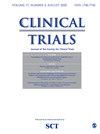Reconsidering stepped wedge cluster randomized trial designs with implementation periods: Fewer sequences or the parallel-group design with baseline and implementation periods are potentially more efficient.
IF 2.2
3区 医学
Q3 MEDICINE, RESEARCH & EXPERIMENTAL
引用次数: 0
Abstract
BACKGROUND/AIMS When designing a cluster randomized trial, advantages and disadvantages of tentative designs must be weighed. The stepped wedge design is popular for multiple reasons, including its potential to increase power via improved efficiency relative to a parallel-group design. In many realistic settings, it will take time for clusters to fully implement the intervention. When designing the HEALing (Helping to End Addiction Long-termSM) Communities Study, implementation time was a major consideration, and we examined the efficiency and practicality of three designs. Specifically, a three-sequence stepped wedge design with implementation periods, a corresponding two-sequence modified design that is created by removing the middle sequence, and a parallel-group design with baseline and implementation periods. In this article, we study the relative efficiencies of these specific designs. More generally, we study the relative efficiencies of modified designs when the stepped wedge design with implementation periods has three or more sequences. We also consider different correlation structures. METHODS We compare efficiencies of stepped wedge designs with implementation periods consisting of three to nine sequences with a variety of corresponding designs. The three-sequence design is compared to the two-sequence modified design and to the parallel-group design with baseline and implementation periods analysed via analysis of covariance. Stepped wedge designs with implementation periods consisting of four or more sequences are compared to modified designs that remove all or a subset of 'middle' sequences. Efficiencies are based on the use of linear mixed effects models. RESULTS In the studied settings, the modified design is more efficient than the three-sequence stepped wedge design with implementation periods. The parallel-group design with baseline and implementation periods with analysis of covariance-based analysis is often more efficient than the three-sequence design. With respect to stepped wedge designs with implementation periods that are comprised of more sequences, there are often corresponding modified designs that improve efficiency. However, use of only the first and last sequences has the potential to be either relatively efficient or inefficient. Relative efficiency is impacted by the strength of the statistical correlation among outcomes from the same cluster; for example, the relative efficiencies of modified designs tend to be greater for smaller cluster auto-correlation values. CONCLUSION If a three-sequence stepped wedge design with implementation periods is being considered for a future cluster randomized trial, then a corresponding modified design using only the first and last sequences should be considered if sole focus is on efficiency. However, a parallel-group design with baseline and implementation periods and analysis of covariance-based analysis can be a practical, efficient alternative. For stepped wedge designs with implementation periods and a larger number of sequences, modified versions that remove 'middle' sequences should be considered. Due to the potential sensitivity of design efficiencies, statistical correlation should be carefully considered.重新考虑有实施期的阶梯楔形分组随机试验设计:更少的序列或带有基线期和实施期的平行组设计可能更有效。
背景/目的在设计分组随机试验时,必须权衡暂定设计的优缺点。阶梯式楔形设计很受欢迎,原因有很多,包括相对于平行组设计,它有可能通过提高效率来增加力量。在许多现实环境中,分组完全实施干预措施需要时间。在设计 HEALing(Helping to End Addiction Long-termSM)社区研究时,实施时间是一个主要考虑因素,因此我们研究了三种设计的效率和实用性。具体来说,一种是带有实施期的三序列阶梯式楔形设计,一种是去掉中间序列后相应的两序列修正设计,还有一种是带有基线期和实施期的平行组设计。本文将研究这些具体设计的相对效率。更广泛地说,我们研究的是当带有实施期的阶梯楔形设计有三个或更多序列时,改进设计的相对效率。我们还考虑了不同的相关结构。我们比较了实施期由三到九个序列组成的阶梯楔形设计与各种相应设计的效率。通过协方差分析,我们将三序列设计与两序列改进设计以及基线期和实施期平行组设计进行了比较。将实施期包含四个或更多序列的阶梯楔形设计与去掉所有或部分 "中间 "序列的改进设计进行比较。结果 在所研究的环境中,改进设计比具有实施期的三序列阶梯楔形设计更有效。基于协方差分析的基线期和实施期平行组设计通常比三序列设计更有效。对于由更多序列组成的有实施期的阶梯楔形设计,通常有相应的改进设计来提高效率。不过,仅使用第一个和最后一个序列可能会相对高效或低效。相对效率受同一群组结果间统计相关性强弱的影响;例如,群组自相关值越小,改进设计的相对效率越高。结论如果在未来的群组随机试验中考虑采用有实施期的三序列阶梯楔形设计,那么如果只注重效率,则应考虑只使用第一和最后序列的相应改进设计。不过,具有基线期和实施期的平行组设计以及基于协方差的分析也是一种实用、高效的替代方法。对于具有实施期和更多序列的阶梯楔形设计,应考虑去除 "中间 "序列的改进版本。由于设计效率的潜在敏感性,应仔细考虑统计相关性。
本文章由计算机程序翻译,如有差异,请以英文原文为准。
求助全文
约1分钟内获得全文
求助全文
来源期刊

Clinical Trials
医学-医学:研究与实验
CiteScore
4.10
自引率
3.70%
发文量
82
审稿时长
6-12 weeks
期刊介绍:
Clinical Trials is dedicated to advancing knowledge on the design and conduct of clinical trials related research methodologies. Covering the design, conduct, analysis, synthesis and evaluation of key methodologies, the journal remains on the cusp of the latest topics, including ethics, regulation and policy impact.
 求助内容:
求助内容: 应助结果提醒方式:
应助结果提醒方式:


